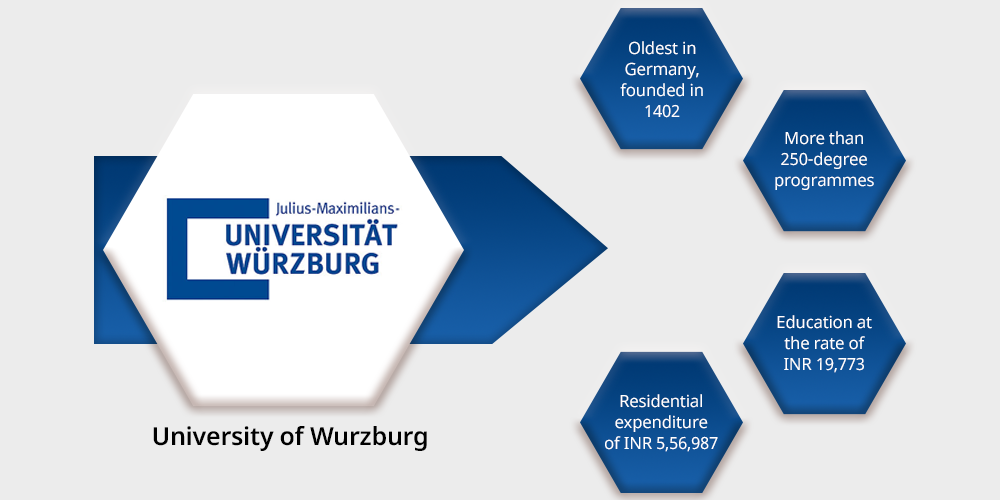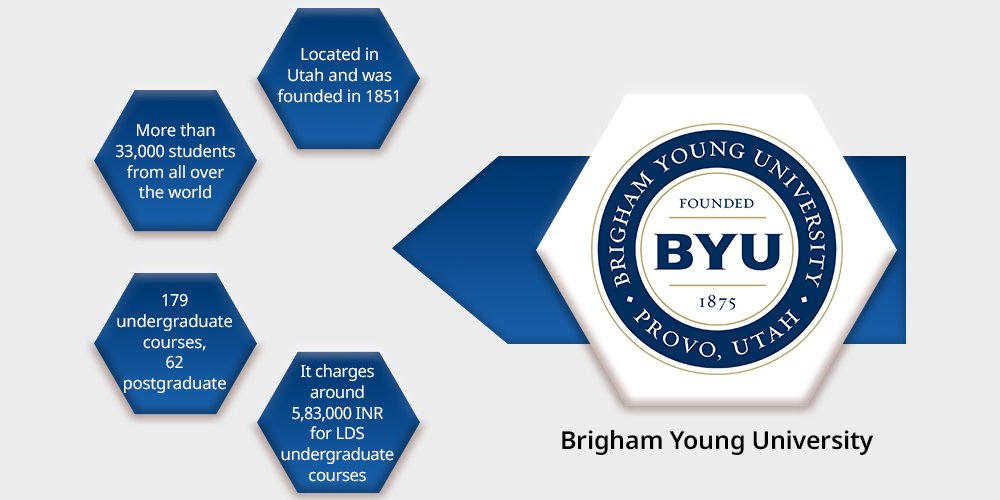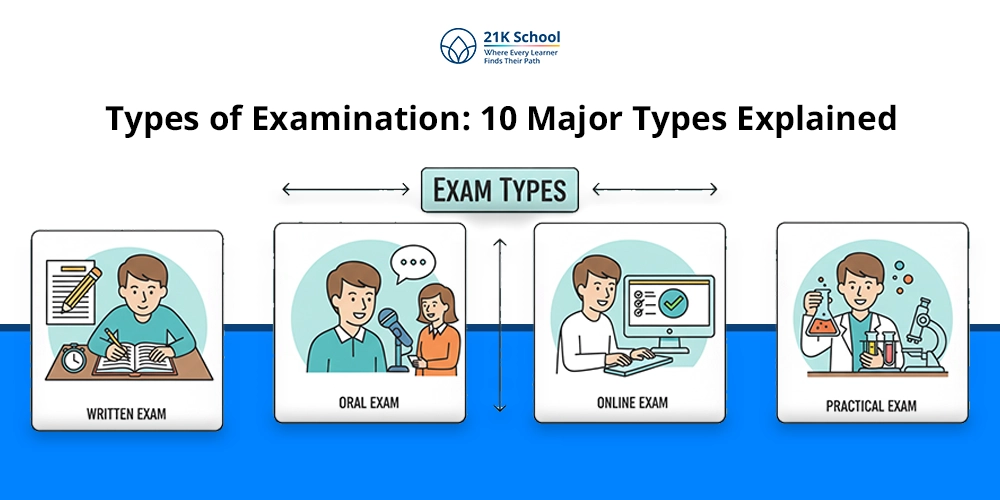
Travelling abroad for quality education does not have to be expensive. There are several low-cost universities all over the world that offer excellent courses at cheaper rates.
Contents
- Top 10 Cheapest Universities in the World for International Students
- Fees Comparison
- Factors to Consider When Choosing an Affordable University
- Cheapest Countries for International Students
- Tuition-Free vs. Low-Cost Universities: What’s the Difference?
- Scholarships and Financial Aid Opportunities
- Benefits of Studying at Low-Cost Universities
- Conclusion
Top 10 Cheapest Universities in the World for International Students
Take a look at the cheapest universities in the world for international students:
1. University of Wurzburg

The Julius Maximilian University of Wurzburg is the oldest in Germany, founded in 1402. The varsity has the vision of “Science for society,” and is regularly working towards advancing research for the future.
There are more than 28,000 students registered in more than 250-degree programmes that are research-centric.
Some popular research-oriented fields are health sciences, quantum phenomena in new materials, molecular chemistry and materials, digital society, global changes, and more.
It is one of the cheapest institutions in the world for higher education. It provides good-quality education at an affordable rate of INR 19,773 and a residential expenditure of INR 5,56,987.
These figures are just an average estimate and may vary according to the present scenario. But you can finish your education for just INR 5,76,878.
2. Brigham Young University

Brigham Young University is a private, non-profit research university. It is located in Utah and was founded in 1851. More than 33,000 students from all over the world study here.
It charges around 5,83,000 INR for LDS undergraduate courses.
This American school provides education in 179 undergraduate courses, 62 postgraduate, and 26 doctoral programmes.
Owing to the funds collected by members of the church, the university is able to offer highly subsidised tuition fees to international students.
And this makes Brigham Young one of the cheapest education-providing universities in the world.
3. Florida State University

Florida State University was founded in 1851. Located in Tallahassee, the university’s main objective is research.
The university has a distinct concept of imparting education to the students studying science, technology, the arts, and other professional and technical fields. More than 30,000 students are part of Florida State University.
Among these, more than 2,000 students are from international destinations. The university offers various undergraduate and postgraduate programmes.
The average cost of education at Florida State is INR 13,50,000. It is one of the cheapest universities in the world in terms of higher education.
4. University of Central Arkansas

It is one of the oldest universities in the USA, established in 1907. The University of Central Arkansas provides education in business, nursing, and physical therapy.
There are more than 12,000 undergraduate and postgraduate students studying at this varsity. Six colleges are part of this university.
These are the College of Education, College of Liberal Arts, College of Health and Behavioral Sciences, College of Business, and College of Fine Arts and Communication.
A student’s education can be obtained at an average cost of INR 5,00,000. The cost of living in the USA varies based on course selection and other factors. Nevertheless, Central Arkansas is one of the cheapest universities in the world.
5. Brandon University

Brandon University in Manitoba, Canada, was established in July 1899. The university aims to make education accessible for all. Courses are offered in humanities, social sciences, and many other fields.
Education is provided with both full-time and part-time degree courses. The school has a distinct methodology for transferring skills to the students.
This university charges INR 3,85,209 for undergraduate programmes and INR 3,07,800 for postgraduate programmes. Who knew studying in Canada could be so affordable?
6. Bucks New University

Buckinghamshire New University in England was founded in 1891. It was given the status of “university” in 2007 and was named Bucks New University.
The school offers various undergraduate and postgraduate degrees in aviation, textiles, music, nursing, management, and film production.
A student can complete their education for just INR 10,00,000, making Bucks one of the cheapest universities in the UK.
7. University of Burgundy

The University of Burgundy in Dijon, France, provides a unique and diverse experience to students studying and living on campus.
The University of Burgundy offers degrees in science, computer science, arts, and humanities. The population of international students on the university campus is more than 11%.
For disabled students studying at the University of Burgundy, management offers a sturdy support system. The tuition for studying in Burgundy based on which course you choose varies between INR 3,00,000 to INR 10,50,000.
8. Osaka University

Osaka University is one of the top three schools in Japan. It is a public university offering degrees in humanities, business, and law at both undergraduate and postgraduate levels.
Courses are offered in English and attract students from all over the world. The average tuition fees for studying in Osaka vary from INR 3,80,000 to INR 5,50,000.
9. University of Warsaw (Poland)
The University of Warsaw is one of the top-ranked institutions in Central Europe, known for its affordable tuition and strong academic reputation.
Founded in 1816, it offers a wide range of English-taught programs across fields like humanities, social sciences, business, and science.
Tuition for international students is quite reasonable, typically ranging from $2,200 to $3,300 per year, making it an attractive option for students on a budget.
Located in Poland’s vibrant capital, the university provides a rich cultural experience and a low cost of living compared to Western Europe.
Its strong ties to global research and academic networks also make it a great choice for those seeking quality education at a low cost.
10. University of Buenos Aires (Argentina)
The University of Buenos Aires (UBA) is one of Latin America’s most prestigious public universities, and one of the few in the world that offers completely free education, even to international students.
Established in 1821, UBA is renowned for its excellence in law, philosophy, medicine, and social sciences. Despite its no-tuition policy, it maintains high academic standards and has produced numerous Nobel Prize winners and notable alumni.
Set in the lively city of Buenos Aires, students enjoy a rich cultural environment, with affordable living costs and diverse opportunities for personal and academic growth.
For students looking for world-class education without the financial burden, UBA is a standout choice.
Fees Comparison
| University | Approx. Annual Tuition (USD) | Notes |
| University of Würzburg (Germany) | $0 | No tuition; small semester fee (around $150–$350). |
| Brigham Young University (USA) | $5,790 | Estimated for international undergraduates; tuition is subsidised. |
| Florida State University (USA) | $21,683 | International undergraduate tuition for 2024–25. |
| University of Central Arkansas (USA) | $17,000–$19,000 | Varies by program; typical for out-of-state/international students. |
| Brandon University (Canada) | $10,000–$12,000 | Undergraduate tuition; graduate tuition is lower. |
| Bucks New University (UK) | $15,500–$18,000 | Standard international undergraduate tuition. |
| University of Burgundy (France) | $185–$4,600 | Bachelor’s tuition is around $185; Master’s tuition varies widely. |
| Osaka University (Japan) | $5,700 + $3,000 one-time | Annual tuition is $5,700; one-time enrollment fee is $3,000. |
| University of Warsaw (Poland) | $2,200–$3,300 | Standard tuition for English-taught programs. |
| University of Buenos Aires (Argentina) | $0 | Tuition-free for undergraduate programs. |
Factors to Consider When Choosing an Affordable University
The following factors should be taken into consideration while choosing a university:
1. Overall Cost of Living
While tuition might be relatively low or even free, the overall cost of living in a city or country can be a significant part of your total expenses.
Rent, transport, food, and healthcare costs vary widely both between countries and regions within a country.
2. Language of Instruction
Make sure that the program you choose is presented in a language you can speak fluently; generally, this will be English for international students.
Some universities have limited programs presented in English, whilst others are fully bilingual.
3. Quality and Accreditation
Low cost does not mean low quality. Always check to see if the university is nationally accredited and also look for internationally ranked universities, alumni success stories, and research output.
4. Availability of Scholarships and Work Opportunities
Even the lowest-cost universities may have scholarships, grants, or on-campus jobs to support international students.
Some countries also allow international students to work part-time while they study.
5. Rules about Visa and Post-Graduation
There are different visa regulations for international students in different countries.
Some countries give you the chance to stay back for some time after graduation and look for employment, but others have stricter rules.
6. Campus Life and Student Services
Affordability doesn’t mean that you have to go without services. Many affordable universities have great support for students, such as counselling, career services, and cultural clubs.
If you have a strong support system while you study, your experience is likely to be more enjoyable and valuable.
Cheapest Countries for International Students
If you want to get the best value for your education, consider the following countries with affordable and legitimate degrees:
- Germany: Most public universities charge no tuition, only nominal semester fees.
- Argentina: Public universities like the University of Buenos Aires are tuition-free, even for international students.
- Poland: Offers affordable education with tuition averaging €2,000–3,000 per year.
- Taiwan: Home to top-ranked universities with tuition as low as $2,000 annually.
- France: Public universities charge around €170–€250 for bachelor’s programs, though living costs can vary.
- Mexico and Turkey: Offer degrees in English at public universities with low tuition and living costs.
Tuition-Free vs. Low-Cost Universities: What’s the Difference?
| Aspect | Tuition-Free Universities | Low-Cost Universities |
| Tuition Fees | No tuition fees at all | Tuition fees are charged, but kept minimal |
| Examples | University of the People, some public universities in Germany | Public universities in India, Mexico, Eastern Europe |
| Hidden/Other Costs | May charge for admin, exams, or tech access | May include lab fees, materials, or subsidised hostel charges |
| Funding Source | Mostly government-funded or donor-supported | Government funding + partial tuition from students |
| Accessibility | High, but competitive; may require a strong academic background | More broadly accessible, with lower entry barriers |
| Accreditation | Varies—some are accredited globally, others may be limited | Generally, nationally accredited with recognised degrees |
| Program Options | Often limited to select disciplines (e.g., tech, business, health) | A broader range of programs, including arts, engineering, etc. |
| Living Expenses | Students must cover their living costs | May offer affordable housing, meals, or stipends |
| Target Students | Students from underserved or low-income backgrounds globally | Students seeking affordable education, especially domestically |
| Availability | Limited to certain countries or online platforms | Available in many countries via public education systems |
Scholarships and Financial Aid Opportunities
Even affordable universities offer scholarships to lighten the financial load. Look for:
- Government Scholarships: e.g., DAAD (Germany), Eiffel Excellence (France), MEXT (Japan), or Fulbright (USA).
- University Scholarships: Many institutions have merit-based or need-based grants for international students.
- Private Scholarships: Offered by foundations, NGOs, or alumni associations, often specific to your field or country of origin.
- Work-Study Programs: Some countries allow part-time student jobs, helping with living costs while gaining experience.
Benefits of Studying at Low-Cost Universities
Studying at a low-cost or tuition-free university offers much more than just savings. Here are some key advantages that make it a smart and practical choice:
1. Lower or No Tuition Fees
Many universities in countries like Germany, Argentina, and France charge either no tuition or a very nominal fee. This allows international students to pursue quality education without draining their finances.
2. High Academic Standards
Affordable universities still maintain strong academic reputations. Many offer modern facilities, qualified faculty, and research opportunities, especially in fields like science, engineering, business, and humanities.
3. International Exposure
Low-cost universities often attract students from across the globe. This multicultural environment helps you build global friendships, improve communication skills, and gain new perspectives.
4. Scholarships and Extra Support
Many of these universities still offer scholarships, fee waivers, or part-time work opportunities to further ease the financial burden.
5. Better Financial Independence
With minimal debt and manageable expenses, students can enjoy greater freedom in career choices, internships, and travel, without constantly worrying about repaying large loans.
Conclusion
So, if you’re looking for quality education but don’t want to break the bank, check out one of these universities.
And please let us know in the comments below if we missed any great (and affordable) schools!



